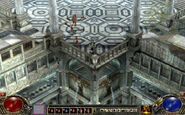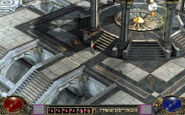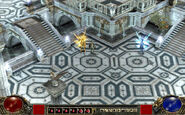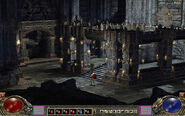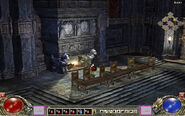
|
This page contains obsolete content This article contains information that is no longer relevant to gameplay. |

One of the game's early screenshots
Diablo III was a game created by Blizzard North. It was a different project from Blizzard South's version.
Plot[]
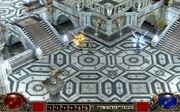
Angels as they would have appeared in the game
An outline for Diablo III existed as early as 2000.[1] At this point in time, the Diablo Writer's Bible (a guide for authors who worked on tie-in novels) held a two paragraph section titled "The Future," which gave a brief plot summary on "what appeared to be Diablo III" (in the words of Robert B. Marks). It stated that this material should not appear in any novel bar through means of vision or prophecy. The paragraphs outlined the Second Great Conflict between order and chaos, mentioning that powerful heroes would emerge, but not specifying who would win.[2]
According to Chris Hartgraves (a former Blizzard North employee), the game was to take place primarily in Heaven.[3] Comments from an art director on the project corraberate this statement. Hartgraves further claimed that the storyline/gameplay would involve Hell trying to take over Heaven.[4]
Gameplay[]
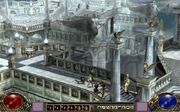
The "Angelic Lands" zone
The game was to be an MMO, with a strong focus on PvP and factions.[5] Multiple players would be present in a zone at any given point in time.[6]
The game would have used a 3D engine, but stay close to the visual tone of the previous entries.[7] Screenshots released in 2011 showed the presence of an "Angelic Lands" zone within Heaven, and another zone simply referred to as "Keep." The player(s) would encounter archangels in Heaven, including Tyrael (these angels had a very different visual style from their Diablo II versions, with said style being carried on to the current Diablo III game), and fight creatures similar to the Bat Demons. At least one class was available, an individual equipped with a sword and shield in a vein similar to the Paladin of Diablo II. The inventory tab was similar to those of the previous games in the series, with health and mana potions numerically assigned and located on the bottom of the screen.[7]
Comparisons were made to World of Warcraft in terms of the game's size and playability. References to guild halls were also made. Every single item in the game was to have a "light" and "dark" version, but apart from a visual change, their stats remained the same.[4] Similarly, an angel/demon "influence system" was experimented with, where players could pick a narrative alignment.[8]
Development[]
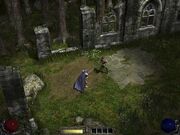
One of the game's earliest screenshots, dated 2001-'03
Blizzard North, the developers of the series's previous games, intended to work on a second expansion to Diablo II. The second expansion would have focused more on expanding Diablo II's multiplayer features. However, after a few brainstorming sessions, the team decided not to follow through on the expansion, and instead turn their attention to Diablo III.[9] The game was inspired by Ultima Online.[10]
Work began in 2001,[11] and by 2003, Blizzard North had created some monster models, such as the Flayed Hound and Immolated Warrior.[12] The game's graphics presented an issue. Few games in the early 2000s were still using 2D technology, but within Blizzard North, the company was working on two separate 3D engines, yet neither were established enough for the game's development.[10]
In 2003, David Brevik and the Schaefer Brothers left Blizzard North. With their resignation, Blizzard South took over (some) control of Blizzard North and gave them a guideline for Diablo III—"make it like Diablo 2." The reason for this was not wanting competition with World of Warcraft, as both games were being developed as MMOs. Thus, their version of Diablo III was scrapped, leaving it to be dubbed internally as "Diablo 2.5."[13] The project would undergo strict supervision from Blizzard South, and North staff members felt this was their last chance to make the project viable. For the next few months, Blizzard North worked on a vertical slice—a small chunk of the game meant to demonstrate how it would feel to play. They built some monsters, some items, and a few dungeon levels to explore. South was satisfied with what they saw as progress, and at the time, most of South's resources were tied up with World of Warcraft. Since Blizzard had no idea how World of Warcraft would turn out, Diablo III was a 'backup game' of sorts. Mike Morhaime returned his attention to World of Warcraft.[14]
However, as time went on, development ran into more problems. Outside North, Blizzard executives like Chris Metzen would come in and offer directions, sending North's staff scrambling. Internally, the team was divided between those who wanted to follow the Diablo II formula, and those who wanted to explore new ideas. The game wasn't making progress in key areas, and when interviewed, Julian Love stated that Diablo III never improved, despite the content being added to it.[14]
This new direction had to change again because of changes in circumstances.[13] However, this version of the game was canceled in 2005, and Blizzard North shut down[12] due to various personal and financial reasons.[3] Reportedly, the game was 33% finished at this time.[13]
Matt Uelmen worked on the score of Blizzard North's version of Diablo III. Reportedly, his music for the game was "big and powerful," shifting away from his previous style. His take on the game's music influenced the game's direction under Blizzard North.[15]
Reboot[]
- Jay Wilson on the game's original version(src)
Blizzard Irvine took over development of Diablo III in 2006, effectively rebooting it.[3]
Screenshots[]
References[]
- ↑ 2015-09-19, I'm the author of Garwulf's Corner and Fooling Garwulf - want to ask me a question?. The Escapist, accessed on 2015-09-19
- ↑ 2015-09-20, I'm the author of Garwulf's Corner and Fooling Garwulf - want to ask me a question?. The Escapist, accessed on 2015-09-20
- ↑ 3.0 3.1 3.2 2011-02-16, The First Screenshots from Blizzard North’s version of Diablo III. Diablo IncGamers, accessed on 2014-05-20
- ↑ 4.0 4.1 2006-02-03, Rumor: Diablo III On the Way? You Better Believe It!. Gaming Steve, accessed on 2014-05-20
- ↑ 2017-07-30, 20 YEARS OF DIABLO: AN IGN RETROSPECTIVE. IGN, accessed on 2017-08-04
- ↑ 2024-06-07, The Making of Diablo - David Brevik Interview. YouTube, accessed on 2024-06-10
- ↑ 7.0 7.1 2011-02-15, This Is What Diablo III Looked Like A Long Time Ago. Kotaku, accessed on 2014-06-29
- ↑ 2022-05-16, Wyatt Cheng Twitter. Twitter, accessed on 2022-05-24
- ↑ 2012-10-08, Blizzard wanted a Diablo for handhelds. Shack News, accessed on 2013-10-11
- ↑ 10.0 10.1 Play Nice: The Rise, Fall, and Future of Blizzard Entertainment, pg. 70
- ↑ David L. Craddock, Twitter. Accessed on 2018-11-19
- ↑ 12.0 12.1 2011-01-09, The Earliest Diablo III Monsters, Revealed. Diablo IncGamers, accessed on 2014-05-20
- ↑ 13.0 13.1 13.2 2009-11-01, Community Spotlight: The man behind the book of Blizzard. Shack News, accessed on 2018-10-08
- ↑ 14.0 14.1 Play Nice: The Rise, Fall, and Future of Blizzard Entertainment, pg. 110, 111
- ↑ 2017-07-30, 20 YEARS OF DIABLO: AN IGN RETROSPECTIVE. IGN, accessed on 2017-07-31
Core Series — Diablo • Diablo II • Lord of Destruction • Diablo Immortal • Diablo III • Reaper of Souls • Rise of the Necromancer • Diablo IV • Vessel of Hatred
Licensed Expansions — Hellfire • Unearthed Arsenal
Tabletop RPGs — Dungeons and Dragons: Diablo II Edition (The Bloodstone Tomb, The Awakening, Diablerie, To Hell and Back, The Secret Cow Level) • Diablo: The Roleplaying Game
Board Games — Diablo Chess • Diablo III Mahjong • Diablo: The Board Game
Re-releases — Diablo Battle Chest • Diablo II: Resurrected • Diablo III: Ultimate Evil Edition • Diablo III: Eternal Collection
Canceled — Salvation • Diablo Junior • Diablo III • Diablo MMO • The King in the North • Project Hades




